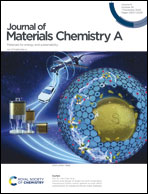Isomeric effects of chlorinated end groups on efficient solar conversion†
Abstract
Isomers with subtle differences in their molecular structure often exhibit different electronic/optoelectronic properties, charge-transport behaviors and photovoltaic performances. In this work, we describe BTIC-2Cl-γ, BTIC-2Cl-δ, and BTIC-2Cl-β, three isomers with acceptor–donor–acceptor–donor–acceptor (A–D–A–D–A) structures, in which a fused benzothiadiazole is the donor (D) unit and a single chlorine atom substituted at the δ, β or γ position of the benzene-fused end groups is the acceptor (A) unit. In general, changes in the position of the chlorine atom were found to lead to significantly different absorptions, energy levels, and photovoltaic performances. Compared to BTIC-2Cl-δ, the BTIC-2Cl-γ isomer shows similar UV/Vis absorption, energy levels, and molecular packing, but slightly better photovoltaic performance. A crystallographic analysis of BTIC-2Cl-δ indicates that the molecules easily form a three-dimensional (3D) network due to the noncovalent interactions of Cl⋯S, Cl⋯π and Cl⋯N. When blended with PBDB-TF as an electron-donor material, the devices based on BTIC-2Cl-γ exhibited higher power conversion efficiency (PCE) of up to 15.04% with an increased voltage (Voc) of 0.90 V, which was better than that of BTIC-2Cl-δ-based devices (14.13%) and much higher than that of BTIC-2Cl-β-based devices (7.39%). Our studies demonstrate that having the chlorine atom at the different positions of the end groups clearly affects the photovoltaic properties of the resulting acceptors.



 Please wait while we load your content...
Please wait while we load your content...